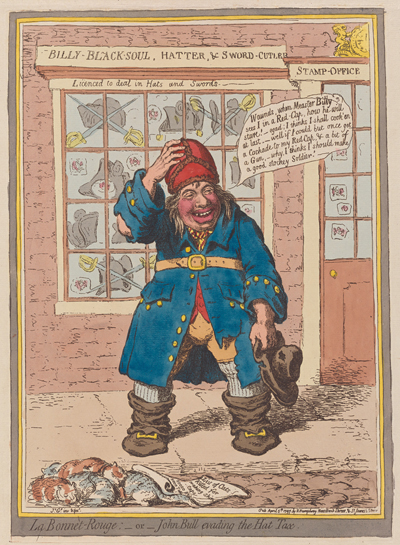Le Bonnet Rouge, or John Bull Evading the Hat Tax
In this print, the prototypical Englishman, John Bull, stands in front a "Hatter & Sword Cutler" shop. The shop belongs to "Billy Black-Soul," i.e. Prime Minister William Pitt, who was responsible for levying an increasingly onerous and wide range of taxes and duties upon products and services of every description (including a tax on hats) to fund the on-going war against France. Like most tax-payers, John is delighted to have found a loophole in the definition of hats in order to evade the tax. But his explanation of his choice of alternative head gear has a far more serious implication for the state of Britain than the loss of a little income.

© Beinecke Rare Book and Manuscript Library, Yale University
Having become Prime Minister in the aftermath of the expensive American war, Pitt spent most of his long tenure as prime minister searching for means of producing revenue. And no sooner did Britain start to get on a sound financial footing in the early 1790's than the war against France created another drain upon the coffers. A quick and partial scan of the duties imposed between 1784 and 1797, including duties upon wines, sweets, sugar, carriages, horses, male servants, dogs, paper, tea, cocoa, glass, bricks, and hair powder, leads one to wonder what could have been left to tax.
But, in fact, it wasn't enough. By 1797, the Bank of England had only gold to back half of the banknotes in circulation. And in the aftermath of yet another attempted invasion of Britain in Fishguard (February 22—24, 1797), Pitt had been forced to enact a Bank Restriction law which suspended the requirement on the Bank of England to pay out gold bullion for banknotes which would have effectively bankrupted the country.
Gillray devoted several of his most famous prints criticizing Pitt and his policy, including Midas, Transmuting All into Paper (March 9, 1797) and Political Ravishment, or the Old Lady of Threadneedle Street in Danger! (May 22, 1797). So we must see this print, Le Bonnet Rouge, or John Bull Evading the Hat Tax, not in the context of the Hat Tax itself which had, in fact, been in effect since 1784, but in the context of the current financial crisis and the continued threat of a French Invasion.
Wounds, when Master Billy sees I in a Red-Cap, how he will stare!—egad; I thinks I shall cook em at last. —well if I could but once get a Cockade to my Red Cap, & a bit of a Gun - why, I thinks I should make a good stockey Soldier!
John Bull is wearing what appears to be an old grenadier's mitre cap, but his emphasis on its color and the astonishment it must cause "Master Billy" (Pitt) forces us to see it, as Gillray does, as a form of "Bonnet Rouge" the cap of a Revolutionist. And John Bull's desire for a cockade and gun suggests that "Billy Black Soul's taxes may have pushed a visibly tattered John Bull to the point where the next French invasion might find in him a willing "stockey Soldier" . . . for France.
I have no reason to disbelieve Gillray, but I cannot find any evidence of caps being made from cat skins. But if true, Gillray reveals a source of outrage I would never have expected. Was he a cat lover?.
Sources and Reading
- Commentary from the British Museum on Le Bonnet Rouge, or John Bull Evading the Hat Tax.
- "Hat tax," Wikipedia
- "Bank Restriction Act 1797," Wikipedia
- Thomas Wright and R.H. Evans, Historical and Descriptive Account of the Caricatures of James Gillray #169
- Thomas Wright and Joseph Grego, The Works of James Gillray, the Caricaturist; With the History of His Life and Times p. 221-222.
Comments & Corrections
NOTE: Comments and/or corrections are always appreciated. To make that easier, I have included a form below that you can use. I promise never to share any of the info provided without your express permission.